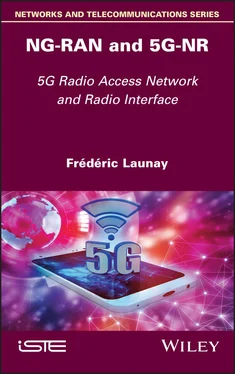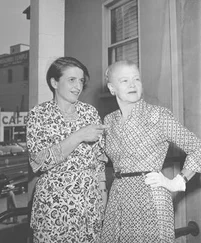3 Chapter 3Figure 3.1. Random access with contention Figure 3.2. Random access without contention, in case of handover Figure 3.3. Procedure for establishing a DRB Figure 3.4. Procedure to add a secondary node. For a color version of this figur...Figure 3.5. Procedure initiated by the eNB to change the secondary node. For a c...Figure 3.6. Removing a secondary node initiated by the eNB entity Figure 3.7. Access radio procedure and beam management. For a color version of t...Figure 3.8. Establishment procedure for the RRC connection Figure 3.9. Registration procedure: authentication and the NAS secure mode. For ...Figure 3.10. Registration procedure – service access and registration. For a col...Figure 3.11. The NG-C interface configuration procedure Figure 3.12. Procedure for updating the AMF function Figure 3.13. The registration procedure option A: selection and reallocation to ...Figure 3.14. The registration procedure – option B: selection and reallocation o...Figure 3.15. The procedure for establishing a PDU session Figure 3.16. Service continuity. For a color version of this figure, see www.ist...
4 Chapter 4Figure 4.1. OFDM modulation on three subcarriers Figure 4.2. 5G-NR multiplexing techniques Figure 4.3. Time structure of the 5G-NR frame Figure 4.4. TDD configuration example Figure 4.5. Resource grid Figure 4.6. Common resource block and physical resource block Figure 4.7. PSS signal generation Figure 4.8. SSB block Figure 4.9. CSI-RS multiplexing multi-ports Figure 4.10. Three examples of the DM-RS signal and mapping on antenna port 0 Figure 4.11. Additional DM-RS mapping on antenna port 0 Figure 4.12. Mapping of DM-RS in the frequency domain Figure 4.13. Multi-port mode (4 DM-RS) in the case of type 1 single-symbol confi...Figure 4.14. Multi-port double-symbol (Table 7.4.1.1.2-1/2 TS 38.211) Figure 4.15. The occasion of the PRS signal Figure 4.16. The mapping of PRS Figure 4.17. The PDDCH channel in a slot and at PRB Figure 4.18. The allocation of the PDSCH message in the time domain (SLIV) Figure 4.19. SRS signal mapping (one or two symbols) Figure 4.20. The DM-RS signal mapping associated with the short and long PUCCH c...Figure 4.21. The mapping of the DM-RS reference signal associated with short and...Figure 4.22. The NR PUCCH format associated with DM-RS
5 Chapter 5Figure 5.1. 5G coverage with DC, CA and SUL (Ericsson). For a color version of t...Figure 5.2. The bandwidth of CA channels (extract from TS 38.101 Figure 5.3A.2-1...Figure 5.3. Definition of the sub-block bandwidth for a non-contiguous intra-ban...Figure 5.4. Aggregation of component carriers Figure 5.5. SUL mode. For a color version of this figure, see www.iste.co.uk/lau...Figure 5.6. L1/L2 control signaling. For a color version of this figure, see www...Figure 5.7. Carrier aggregation procedure. For a color version of this figure, s...Figure 5.8. The transmission of acknowledgments on two PUCCH channels. For a col...Figure 5.9. SUL mode with coexistence LTE and without coexistence. For a color v...
6 Chapter 6Figure 6.1. SU-MIMO mechanism Figure 6.2. MU-MIMO mechanism Figure 6.3. Beamforming Figure 6.4. Beamforming in horizontal and vertical planes (source: NTT Docomo Te...Figure 6.5. Active antennas Figure 6.6. Mapping models between TXU/TRU units and the antenna elements Figure 6.7. Beamforming architecture Figure 6.8. Antenna configuration Figure 6.9. Single panel and sub-array panel Figure 6.10. The structure of multi-panels Figure 6.11. MIMO transmitter scheme Figure 6.12. Massive-MIMO transmission chain Figure 6.13. Single CSI-RS and multiple CSI-RS methods Figure 6.14. The relationship between the number of lobes, the beamwidth and the...Figure 6.15. SSB block on the temporal domain Figure 6.16. SSB position relative to PRB Figure 6.17. Beam selection procedure
7 Chapter 7Figure 7.1. Bandwidth part Figure 7.2. Remaining minimum information system. For a color version of this fi...Figure 7.3. Data structure of MIB. MSB: Most Significant Bit, LSB: Least Signifi...Figure 7.4. CORESET#0 configuration with index 14. For a color version of this f...Figure 7.5. SIB1 data structure. For a color version of this figure, see www.ist...Figure 7.6. BWP switching. For a color version of this figure, see www.iste.co.u...
8 Chapter 8Figure 8.1. Data link layer protocol. For a color version of this figure, see ww...Figure 8.2. PDU session. For a color version of this figure, see www.iste.co.uk/...Figure 8.3. PDU session and QoS flow. For a color version of this figure, see ww...Figure 8.4. SDAP frame structure Figure 8.5. Header compression. AMR: Adaptive Multi-Rate Figure 8.6. PDCP operations relating to the SRB bearer1 Figure 8.7. PDCP operations relating to the DRB bearer Figure 8.8. NR-PDCP frame structure. For a color version of this figure, see www...Figure 8.9. Operating mode of the RLC protocol. MBMS: Multicast Broadcast Figure 8.10. TM mode operations Figure 8.11. UM mode operations Figure 8.12. AM mode operation Figure 8.13. RLC frame structure – UM mode Figure 8.14. RLC structure of frame – AM mode Figure 8.15. Structure of an RLC frame – AM mode Figure 8.16. RLC protocol control message Figure 8.17. MAC operation gNB side Figure 8.18. MAC Operation: UE side Figure 8.19. Structure of MAC frame (L in octet) Figure 8.20. MAC RAR structure of frame
9 Chapter 9Figure 9.1. PBCH physical channel. For a color version of this figure, see www.i...
1 Chapter 1 Table 1.1. RRC mobile states Table 1.2. 5G QoS characteristics
2 Chapter 2Table 2.1. XnAP elementary procedures – Class 1 Table 2.2. XnAP elementary procedures – Class 2 Table 2.3. F1 elementary procedures – Class 1 Table 2.4. F1 elementary procedures – Class 2 Table 2.5. NG-AP elementary procedures – Class 1 Table 2.6. NG-AP elementary procedures – Class 2
3 Chapter 4Table 4.1. Frequency band FR1 5G-NR Table 4.2. Frequency band FR2 5G-NR Table 4.3. FFT length according to the 5G bandwidth and SCS Table 4.4. Structure of the NR frame in the time domain Table 4.5. Prefix cyclic per numerology Table 4.6. The structure of the resource grid in the temporal domain Table 4.7. SSB mapping Table 4.8. CDM multiplexing for multi-port CSI-RS Table 4.9. Frequency offset Table 4.10. Radio identifier associated with the DCI format Table 4.11. The allocation of PDSCH in the time domain (TS 38.214, Table 5.1.2.1...Table 4.12. The length of RBG in function of the bandwidth (TS 38.214, Table 5.1...Table 4.13. The structure of a long PRACH sequence Table 4.14. The structure of short PRACH sequences Table 4.15. PUCCH format
4 Chapter 5Table 5.1. Carrier aggregation class on band FR1 Table 5.2. List of contiguous intra-bands for carrier aggregation FR1 Table 5.3. Configuration for contiguous intra-band carrier aggregation Table 5.4. Non-contiguous intra-band aggregation carrier in the FR1 band Table 5.5. Configuration of non-contiguous carrier aggregation intra-band Table 5.6. Inter-band carrier aggregation Table 5.7. Carrier aggregation of the FR2 band Table 5.8. Carrier aggregation intra-band in FR2 Table 5.9. Contiguous intra-band carrier aggregation in the FR2 band Table 5.10. Maximum spacing of CC radio channels
Читать дальше












